As the site is updated, each listing includes the shipping cost. Some listings which I have not updated still give you calculated shipping costs based on weight and size of package. (In the sections I have updated) If you select several different listings, we will consolidate your order and charge you the actual cost of the entire package. The shipping over charge will be refunded to you, when your order is shipped.
COCKLE SHELLS FOR COLLECTORS AND CRAFTERS
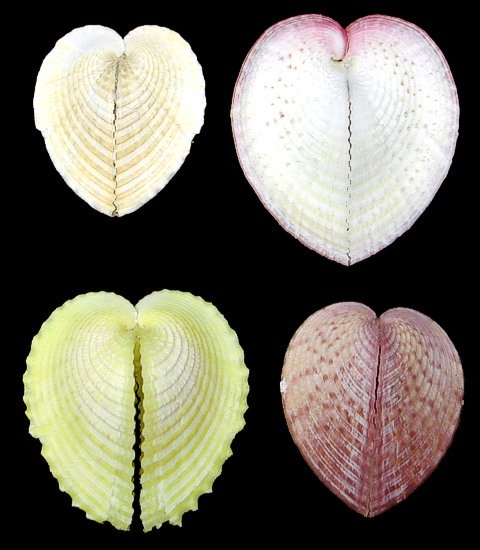
Corculum cardissa
Common name heart cockle
N2-14
Three Cardium Cardissas (Heart cockle Shell) natural color (mostly white to cream color) measuring .75 to 2 inches...... $6.75Corculum cardissa
common name the heart cockle, is a species of marine bivalve mollusk in the family Cardiidae. They are found in the Indo-Pacific region.
bivalve, (class Bivalvia), any of more than 15,000 species of clams, oysters, mussels, scallops, and other members of the phylum Mollusca characterized by a shell that is divided from front to back into left and right valves. The valves are connected to one another at a hinge.
The two valves of Corculum cardissa are unequal in size and often asymmetric. Their shape varies, when viewed from above, the outline is roughly heart shaped which gives the mollusks their common name. Viewed from the side the shape bears a resemblance to the shell of a cockle. In some specimens the posterior valve is nearly flat or has a slight hump. In others it is more rounded.
The boundary of the valves is usually flat but is sometimes somewhat sinuous. Smaller shells tend to be elongated; larger shells are more rounded and the growth rings can be seen clearly. The shell is thin and translucent, particularly the upper side. There is an intricate mosaic pattern of more and less transparent white regions. The lower valve has a mainly white surface with a few transparent regions. The gills and mantle, especially the lower siphon, are dark brown owing to the presence of microscopic algae. The outer surface of the mantle also contains granules of reddish, purple and blue pigment.
Sinuous means having many curves, bends, turns or winding.
Corculum cardissa is often found lying on a surface of sand among coral debris and broken shells. They usually lye horizontally in a hollow it excavates and its top is often covered with filamentous algae and muddy deposits.
filamentous A fine or very thin thread or fiber: filaments of cloth; filaments of flax.
Corculum cardissa is a filter feeder. The shell gapes slightly at the ventral end and two siphons are protruded. Water is drawn in through one and expelled through the other and plankton and detritus are extracted. At the same time, water passes over the gills where oxygen is absorbed.
Corculum cardissa is a hermaphrodite. Eggs are laid and the larvae develop with great rapidity. Within 24 hours of fertilisation, the veliger larvae have been observed to develop two valves and be swimming on the surface of the substrate. A day later, they had undergone metamorphosis and had settled on the bottom as juveniles, miniature versions of the adult bivalves.
A hermaphrodite is a sexually reproducing organism that produces both male and female gametes.[1] Animal species in which individuals are of different sexes, either male or female but not both, are gonochoric, which is the opposite of hermaphroditic.
Scientific classification
Domain: Eukaryota
Kingdom: Animalia
Phylum: Mollusca
Class: Bivalvia
Order: Cardiida
Family: Cardiidae
Genus: Corculum
Species: Corculum cardissa
Binomial name: Corculum cardissa
(Linnaeus, 1758)
(REF: Corculum cardissa (Linnaeus, 1758) World Register of Marine Species. )(REF: Kawaguti, Siro. "Observations on the heart shell, Corculum cardissa (L.), and its associated Zooxanthellae" (PDF). Pacific Science. 4)(REF: Farmer, MA; Fitt, WK; Trench, RK (2001). "Morphology of the Symbiosis Between Corculum cardissa (Mollusca: Bivalvia) and Symbiodinium corculorum (Dinophyceae)". Biological Bulletin. 200 )(REF: Avise JC (2011-03-18). Hermaphroditism: A Primer on the Biology, Ecology, and Evolution of Dual Sexuality. Columbia University Press)(REF: Leopold, Luna B., Wolman, M.G., and Miller, J.P., 1964, Fluvial Processes in Geomorphology, San Francisco, W.H. Freeman and Co.)
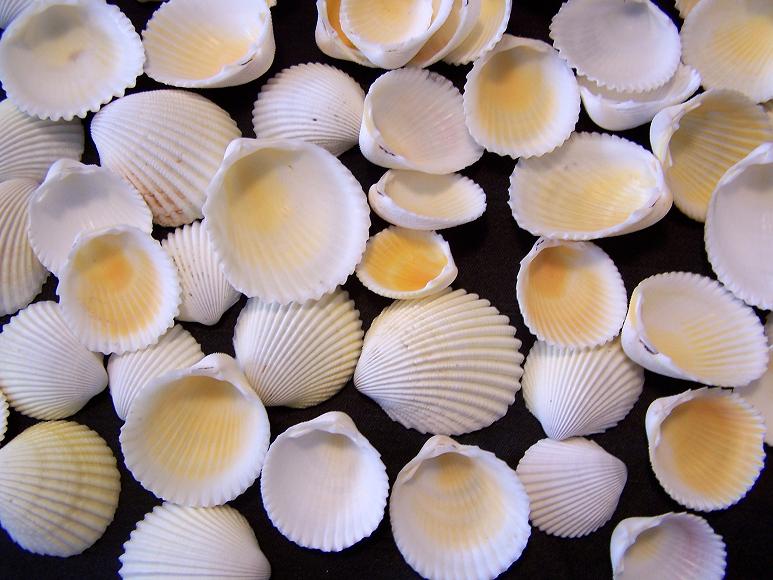
Butter Cream Cockle
Butter Cream Cockles are found in the Western Atlantic Basin. There color ranges from very light off white or light cream to a sunset yellowish tint. They are a commonly found shell.
bcckl
One quarter pound of Butter Cream Cockle shells measuring 2.5 inches or less...... $7.25
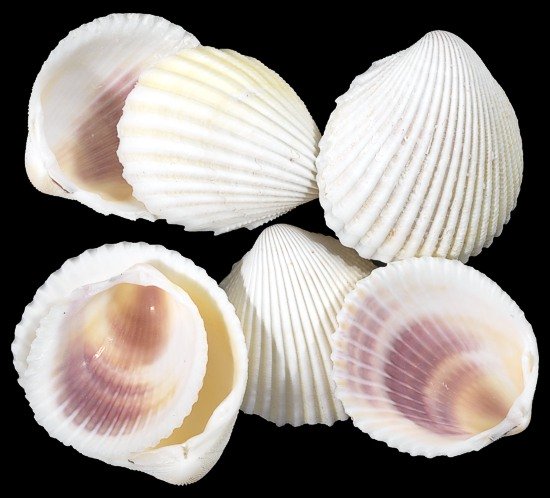
ROSE COCKLE
The Rose Cockle are found across tashe Indo-Pacific Region. The Indo-Pacific region stretches from the Indian Ocean east to the Sea of Japan and south to the New Zealand shores.
The Rose Cockle shells are popular among crafters due to its inner shell colors. Rose Cockle inner shell color can vary, from deep purple to a much lighter purple hue.
R1-9
A quarter pound of Rose Cockle shells measure 2.5 inches or less...... $8.25
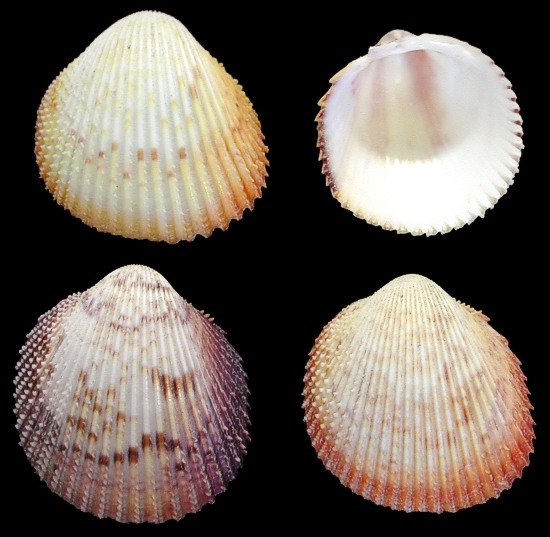
HAITION ROSE COCKLE
The Haition Rose Cockle is a shallow water species found across the Indo-Pacific region.
The Haition Rose Cockle are sold as single shells, not as a complete bivalve, with its matching top and bottom.
P1-14
Twenty Haition Rose Cockles ranging 1/2 to 2.25 inches inch......$6.25
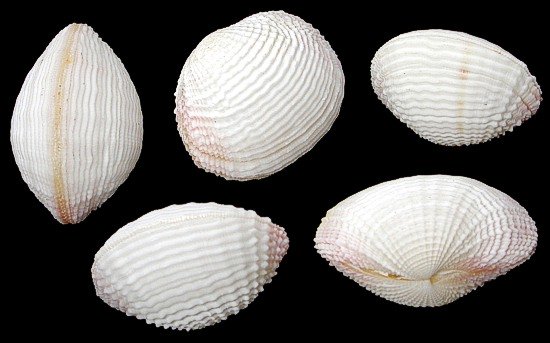
AMERICAN COCKLE SHELL
The American Cockles are complete shells (bivalve) having top and matching bottom of shell. As shown in picture they are shipped sealed a a complete shell.
W0-10
One American Cockle Shell measuring 1.5 to 2 inches...... $5.25
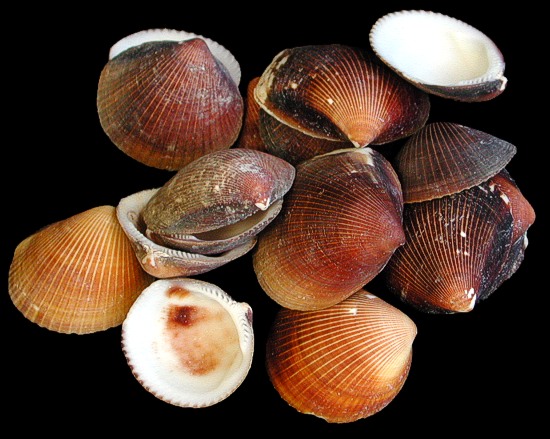
BROWN COCKLE SHELL
The Brown Cockle shell is found across the tropical western Pacific, dwelling in shallow sandy areas of the sea floor.
The Brown Cockle is a common cockle bivalve. We do not sell these as the complete bivalve but as a single shell.
R2-9
Twenty Brown Cockle Shells measuring 1 1/2 inches or less...... $5.35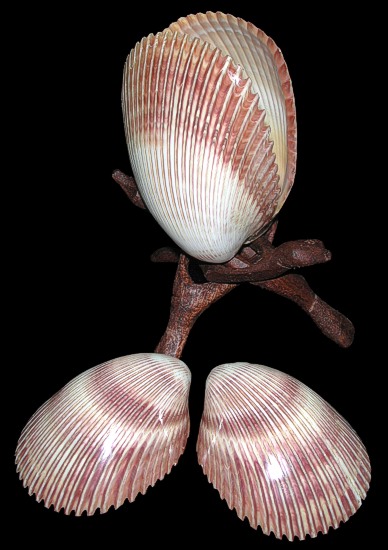
GIANT POLISHED COCKLE SHELL
L0-9
One complete polished Giant Cockle Shell size ranging between 4 to 4.5 inches......$7.35
The Giant Cockle is a bivalve shell. This means the mollusk (animal inhabiting the shell) creates a top and matching bottom shell. The Giant Cockle as well as other cockle shells move thru the water by using their long powerful foot. The foot allows them to leap several inches as they move across muddy or sand bottom sea floors.
The Giant cockle is found across the Indo-Pacific region, ranging from East African shores east to The northern Australian and New Zealand shoreline. They prefer moderately shallow water.
Historically, Most cockle shell species have been a means of food for man as well as some predatory fish. This species has been known to reach 5 inches in size. The Giant Cockle is relatively common.
The picture shows the shape, color and unique markings of the Giant Cockle. The picture provides a good example of the complete bivalve shell top and matching bottom. These Cockles are sold as pairs, matching top and bottom of this bivalve.
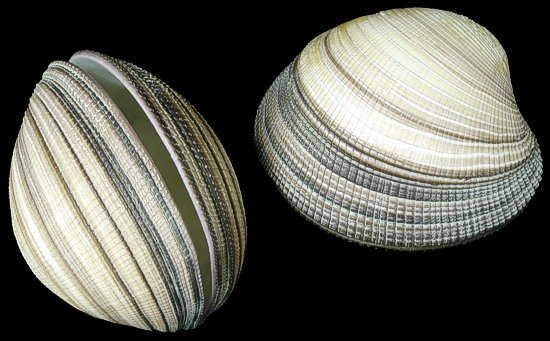
NATURAL HEAVY COCKLE SHELL
The Heavy Cockle is a bivalve shell. This means the mollusk (animal inhabiting the shell) creates a top and matching bottom shell. The Heavy Cockle like the Giant Cockle shells move thru the water by using their long powerful foot. The foot allows them to leap several inches as they move across muddy or sand bottom sea floors.
The Heavy Cockles are found across the Indo-Pacific region, ranging from East African shores east to The northern Australian and New Zealand shoreline. They prefer moderately shallow water. Historically, Most cockle shell species have been a means of food for man as well as some predatory fish. This species has been known to reach 5 inches in size. The Heavy Cockle is considered common.
These are bivalves and are sold with their matching top and bottom. Top and bottom are shipped sealed together.
W1-6
One complete polished Natural Heavy Cockle shell with a matching top and bottom shell measuring 3.5 to 5 inches......$7.99
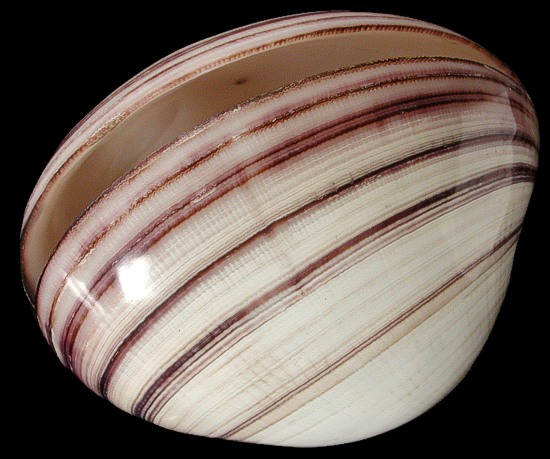
NATURAL POLISHED COCKLE SHELL
The Heavy Cockle is a bivalve shell. This means the mollusk (animal inhabiting the shell) creates a top and matching bottom shell. The Heavy Cockle like the Giant Cockle shells move thru the water by using their long powerful foot. The foot allows them to leap several inches as they move across muddy or sand bottom sea floors.
The Heavy Cockle is found across the Indo-Pacific region, ranging from East African shores east to The northern Australian and New Zealand shoreline. They prefer moderately shallow water.
Historically, Most cockle shell species have been a means of food for man as well as some predatory fish. This species has been known to reach 5 inches in size. The Heavy Cockle is common.
These bivales are sold complete with their matching top and bottom sealed together.
J1-3
One polished Heavy Cockle shell pair with a matching top and bottom shell measuring 4 to 4.5 inches...... $10.65
Cockle Shell
A cockle is an edible marine bivalve mollusk. Many small edible bivalves are loosely called cockles, true cockles are species in the family Cardiidae.
A bivalve is an animal that has two hinged shells, which are called valves. All bivalves are mollusks. Examples of bivalves are clams, mussels, oysters, and scallops. Bivalves are found in both freshwater and marine environments.
There are about 10,000 species of bivalves.Bivalves range in size from less than a millimeter to close to 5 feet (e.g., the giant clam).
A bivalve's shell is formed of calcium carbonate that is secreted from the bivalve's mantle, which is the soft wall of the animal's body. The shell grows as the organism inside gets bigger. Not all bivalves have externally visible shells - some are small, some are not even visible. Shipworms are a bivalve that doesn't have a very visible shell - their shell is made up of two valves at the worm's anterior (back) end.
Bivalves have a foot, but not an obvious head. They also don't have a radula or jaws. Some bivalves move around (e.g., scallops), some burrow into the sediment (e.g., clams) or even rocks, and some attach to hard substrates (e.g, mussels).
True cockles live in sandy, sheltered beaches throughout the world. The distinctive rounded shells are bilaterally symmetrical, and are heart-shaped when viewed from the end. Numerous radial, evenly spaced ribs are a feature of the shell in most but not all genera.
genera is the plural of genus. Genus is a group of species that are closely related through common decent and belong to a taxon called taxongenera.
The shell of a cockle is able to close completely (i.e., there is no "gap" at any point around the edge). The shell of a cockle may resemble that of a scallop because of the ribs, cockles can be distinguished from scallops morphologically in that cockle shells lack "auricles" (triangular ear-shaped protrusions near the hinge line) and scallop shells lack a pallial sinus. Behaviorally, cockles live buried in sediment, whereas scallops either are free-living and will swim into the water column to avoid a predator, or in some cases live attached by a byssus to a substrate.
A byssus is a bundle of filaments secreted by many species of bivalve mollusks that function to attach the mollusk to a solid surface.
A substrate is the base layer of something, or a layer that's underneath another layer. It can also be a surface on which an organism grows or is attached.
The mantle has three apertures (inhalant, exhalant, and pedal) for siphoning water and for the foot to protrude. Cockles typically burrow using the foot, and feed by filtering plankton from the surrounding water. Cockles are capable of "jumping" by bending and straightening the foot. As is the case in many bivalves, cockles display gonochorism (the sex of an individual varies according to conditions),[3] and some species reach maturity rapidly.
The common name cockle is also given by seafood sellers to a number of other small, edible marine bivalves which have a somewhat similar shape and sculpture, but are in other families such as the Veneridae (Venus clams) and the ark clams (Arcidae). Cockles in the family Cardiidae are sometimes referred to as "true cockles" to distinguish them from these other species.
There are more than 205 living species of cockles.
The common cockle, (Cerastoderma edule), is widely distributed around the coastlines of Northern Europe, with a range extending west to Ireland, the Barents Sea in the north, Norway in the east, and as far south as Senegal.
This species is also used in aquaculture. Farming of cockles is ongoing in the UK, the Netherlands and Portugal. However, production in those countries has not been very stable. Future success of aquafarming is very much in question.
The dog cockle, Glycymeris glycymeris, has a similar range and habitat to the common cockle, but is not at all closely related, being in the family Glycymerididae. The dog cockle is edible, but due to its toughness when cooked it is generally not eaten, although a process is being developed to solve this problem.
The blood cockle, Tegillarca granosa (not related to the true cockles, instead in the ark clam family, Arcidae) is extensively cultured from southern Korea to Malaysia.
Scientific classification
Domain: Eukaryota
Kingdom: Animalia
Phylum: Mollusca
Class: Bivalvia
Order: Cardiida
Superfamily: Cardioidea
Family: Cardiidae
Lamarck, 1809
(REF: Schneider, Jay A. (1995). "Phylogeny of the Cardiidae (Mollusca, Bivalvia): Protocardiinae, Laevicardiinae, Lahilliinae, Tulongocardiinae subfam. n. and Pleuriocardiinae subfam. n.". Zoologica Scripta. 24 )(REF: >MolluscaBase eds. (2022). MolluscaBase. Cardiidae Lamarck, 1809. Accessed through: World Register of Marine Species)(REF: "Synthesis on biology of Common European Cockle (Cerastoderma edule" (PDF). Reservebaiedesaintbrieuc.com. )(REF: Bieler, Rüdiger; Carter, Joseph G.; Coan, Eugene Victor (2010). "Classification of Bivalve families". Nomenclator of Bivalve Families with a Classification of Bivalve Families. Vol. 52)(REF: Bivalve Seashells of Tropical West America: Marine Bivalve Mollusks from Baja California to Northern Perú. Santa Barbara Museum of Natural History)(REF: Cunningham, Joseph Thomas (1911). "Cockle" . Encyclopædia Britannica. Vol. 6)